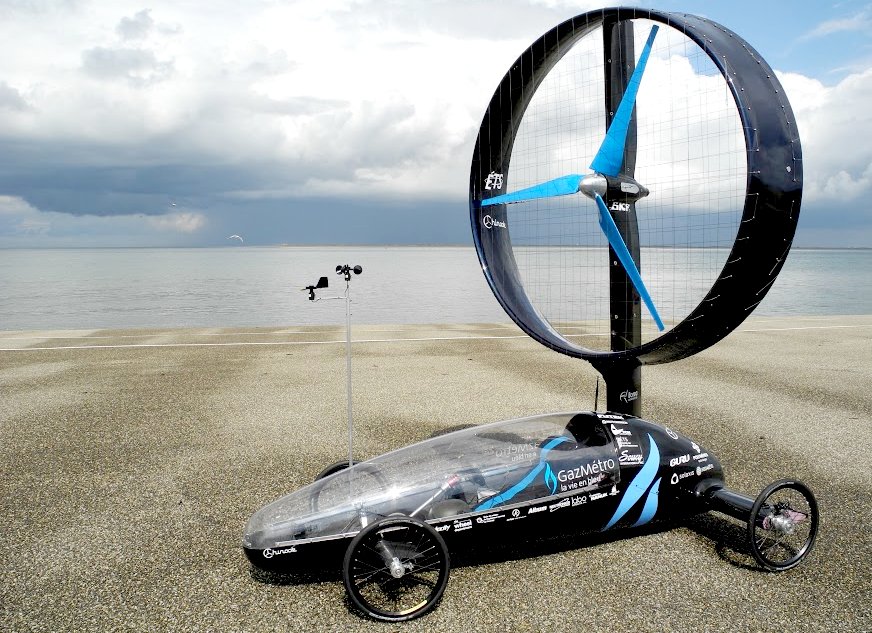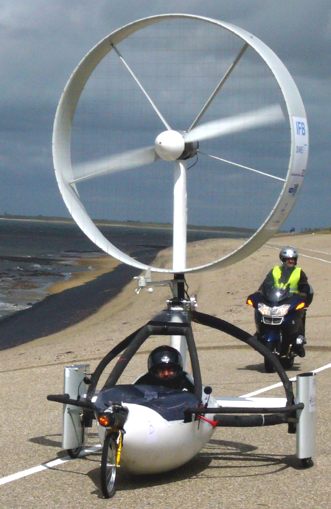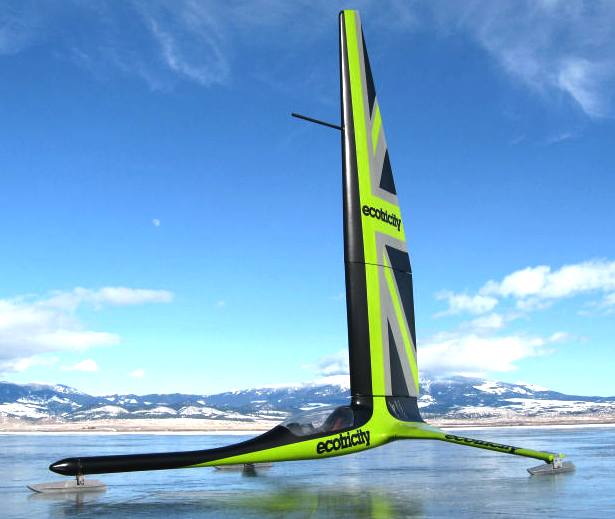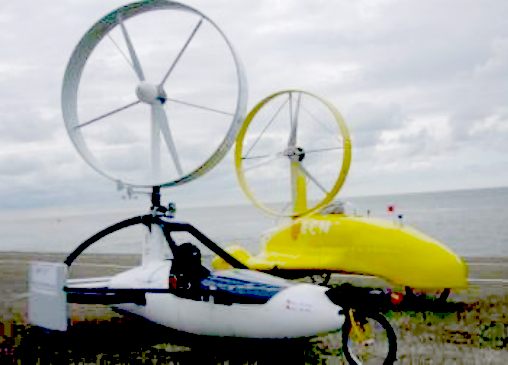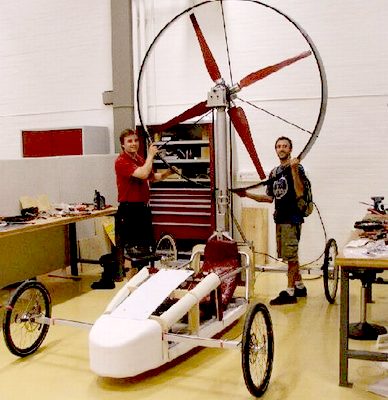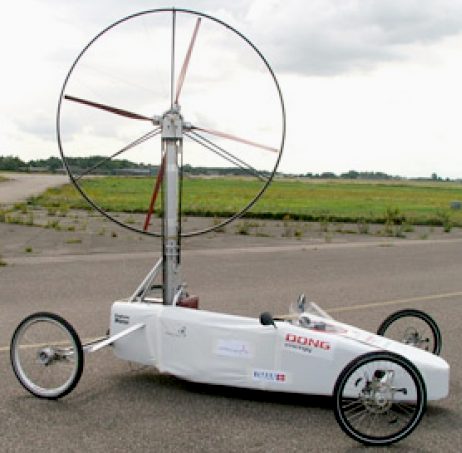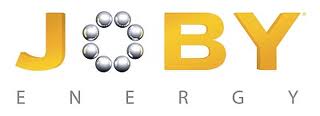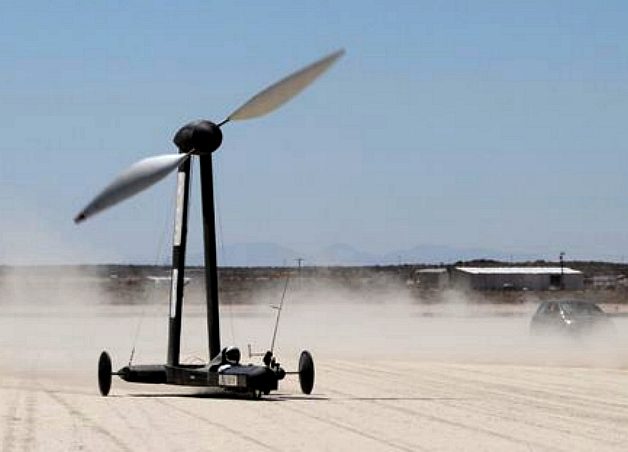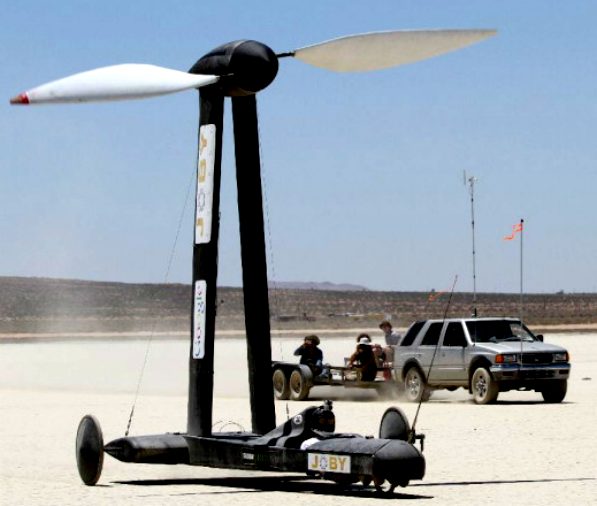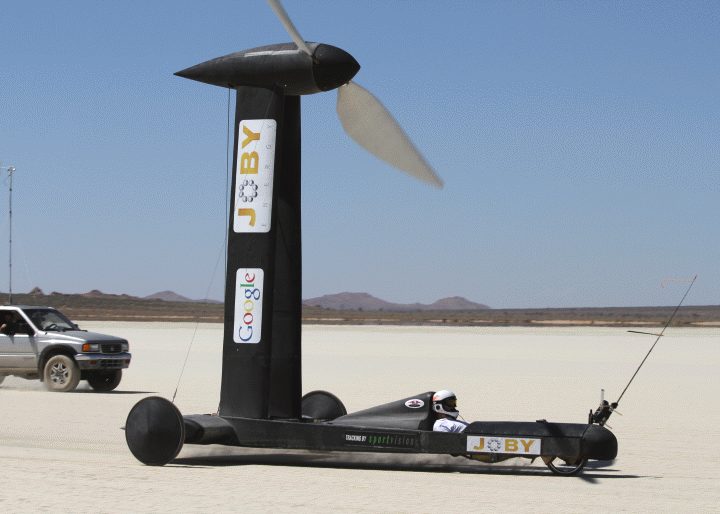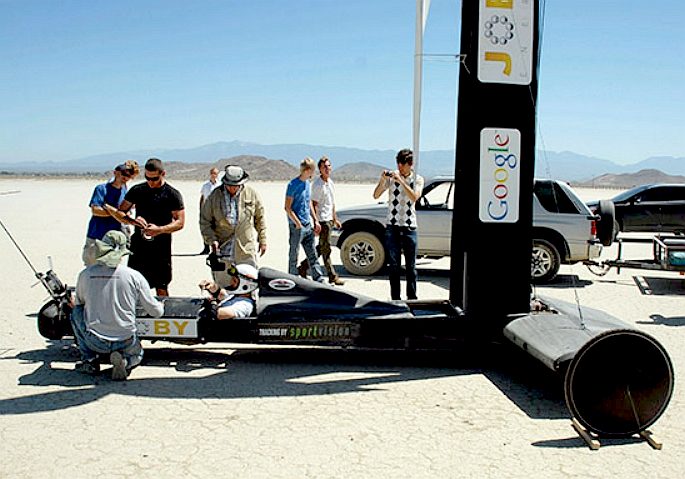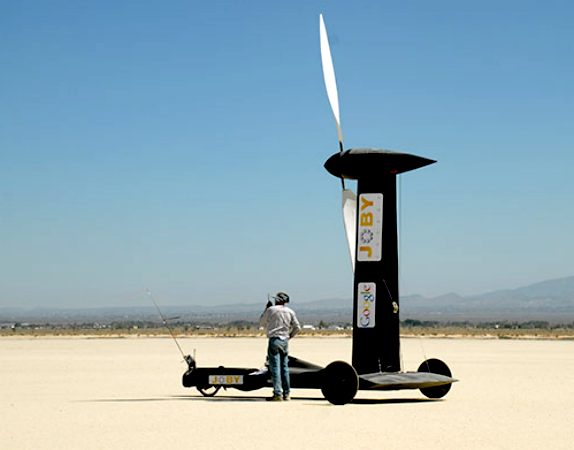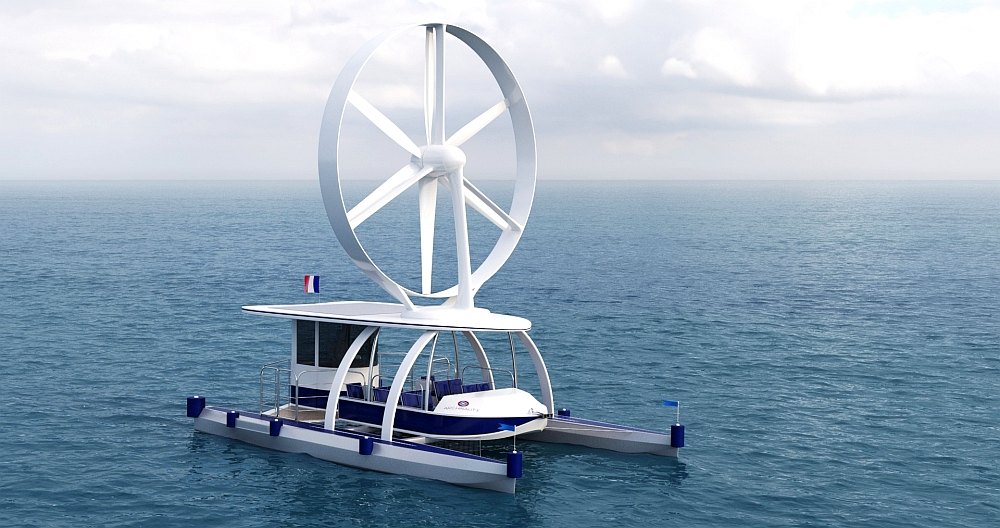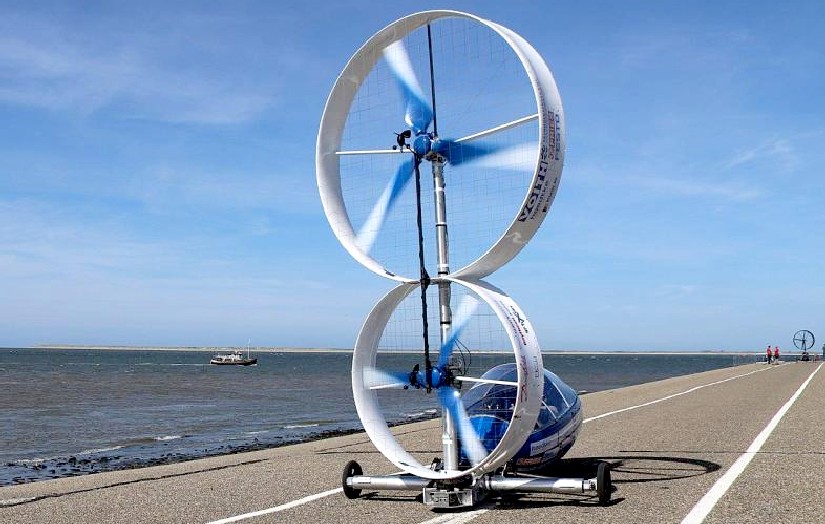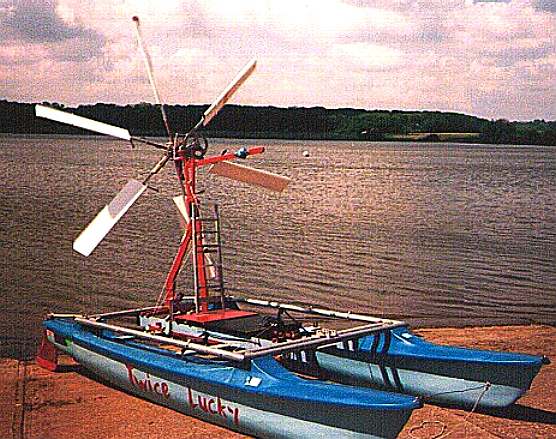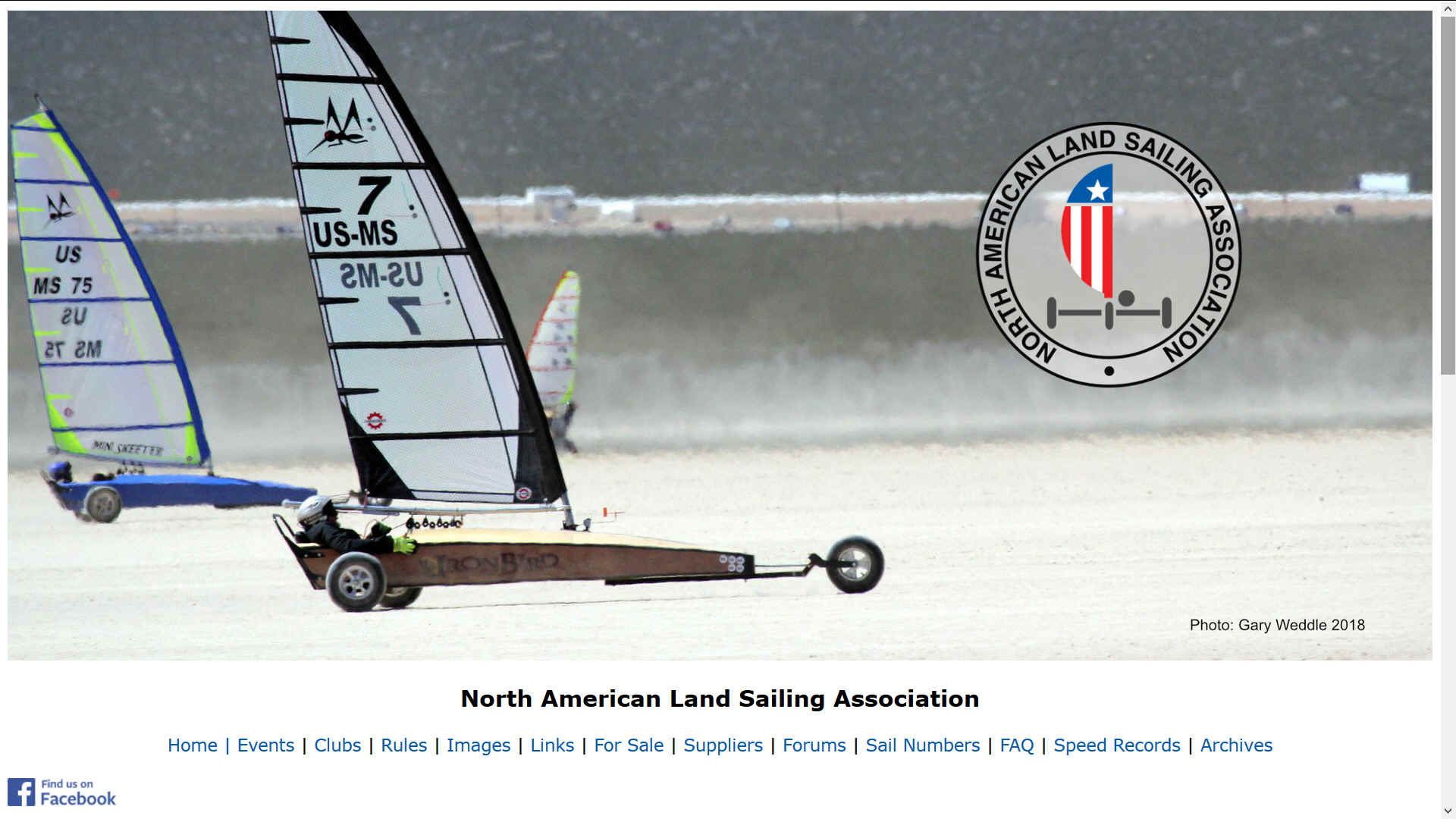|
WIND POWERED LAND TRANSPORT
HOME | AUTOMOTIVE | CANNONBALL | CLIMATE A TO Z | ENERGY | FORMULA E | SOLAR CARS PLEASE USE OUR A TO Z INDEX TO NAVIGATE THIS SITE |
|||||||||||||||||||||||||||||||||||||||||||||||||||||
|
Den Helder - The Chinook team from Canada won Racing Aeolus Den Helder in 2019. With a fastest lap of 114.82 percent, a new world record was also set.
TURBINE POWERED LAND VEHICLES WORK JUST FINE
Wind-powered mechanical vehicles use wind turbines installed at a strategic point of the vehicle from which wind energy is converted into mechanical energy through gears, belts or chains, causing the vehicle to propel forward. They are not in mainstream use yet, but many schools have begun researching the new technology as part of their curricula. The Blackbird below uses chain drive to the driven wheels, the Ventmobile uses a wind turbine generator to drive electric traction motors.
Left: the "Inventus Ventmobile" at the Aeolus electric formula zero land race 2008. Right: On March 26 2009, on the ‘dry’ Lake Ivanpah, the Greenbird driven by British engineer, Richard Jenkins, smashed the world land speed record for wind powered vehicles. The Greenbird clocked 126.1 mph (202.9 km/h) eclipsing the American held, record of 116 mph, set by Bob Schumacher in the Iron Duck in March 1999 at the same location.
"Do you think this will ever catch on?" "Who cares so long as we get to work on time."
BLACKBIRD
The Blackbird is an experimental land yacht, built to demonstrate that it is possible to sail directly downwind faster than the wind.
Conventional sail-driven boats, not going directly downwind, can achieve speeds - reaching the destination downwind, at a greater speed than the wind on line to the destination, in what is called velocity made good but cannot move faster than the wind while sailing in the same direction as the blowing wind ("dead downwind").
By using a propeller instead of a conventional sail, and coupling the propeller to its wheels, a land yacht can proceed dead downwind faster than the wind.
Made from mostly lightweight foam, the aerodynamic shell sports a 17-ft. tall propeller. Bicycle wheels re-engineered with go-kart hubs (to handle side-load) were installed, and, after more than a year of trial and error, a transmission was developed capable of transferring power from the wheels to the giant prop without breaking.
ACHIEVEMENTS
On 7 and 8 March 2010, the team reported testing their vehicle on a motor-driven moving belt (treadmill), showing that it would advance against the belt, which means that it can progress dead downwind faster than the wind.
On 24 March 2010, the team ran the vehicle on the Ivanpah dry lake bed south of Las Vegas, Nevada, showing that it could accelerate dead downwind from a standstill and reach velocities well in excess of wind speed. That is, the vehicle was progressing dead downwind faster than the wind. Officials of the North American Land Sailing Association (NALSA) were in attendance and one NALSA Board of Directors member (Bob Dill) was there for every run and collected his own rough wind and GPS data. This was not a NALSA sanctioned event but was presented as a demonstration to the NALSA Board of Directors that the vehicle was capable of progressing dead downwind faster than the wind. Subsequently, the team worked out the details with NALSA for rules and instrumentation related to an upcoming official NALSA ratified test and record.
On July 2, 2010, Blackbird set the world's first certified record for going directly downwind, faster than the wind, using only power from the available wind during its run. The yacht achieved a dead downwind speed of about 2.8 times the speed of the wind.
On June 16, 2012, Blackbird set the world's first certified record for going directly upwind, without tacking, using only power from the wind. The yacht achieved a dead upwind speed of about 2.1 times the speed of the wind.
The Google sponsored Blackbird (faired on the left, bare chassis on the right) which in 2010 successfully achieved more than 2 times the speed of the wind downstream, then in 2011 reached close to 3 times the speed of wind, suggestive that into the wind 1.5 times the speed of the wind is theoretically possible for the Bluefish ZCC, save that water drag is much higher than road drag from bearings and wheels. Don't try this at home children.
Joby Energy is developing airborne wind turbines to operate in the upper boundary layer. Recent advances in power electronics, sensors, and control systems make this technology practical. Joby's multi-wing structure supports an array of turbines. The turbines connect to motor-generators which produce thrust during takeoff and generate power during crosswind flight. Orientation in flight is maintained by an advanced computer system that drives aerodynamic surfaces on the wings and differentially controls rotor speeds. A reinforced composite tether transmits electricity and moors the system to the ground. For launch, the turbines are supplied with power to enable vertical takeoff. Once operating altitude is reached the system uses the power of the wind to fly crosswind in a circular path. The high crosswind speeds result in the generators spinning at high speeds increasing efficiency. Energy is transferred to the ground through an electrical tether. If wind speed drops the turbines are again powered to land the system safely.
The same principle that applies to land vehicles, may also be applied to boats and maybe one day ships, in the battle to overcome global warming.
ROTOR POWERED VEHICLES - Rotor-powered vehicles are wind-powered vehicles that use rotors - instead of sails - which may have a shroud around them (ducted fan) or constitute an unducted propeller, and which may adjust orientation to face the apparent wind. The rotor may be connected via a drive train to wheels or to a generator that provides electrical power to electric motors that drive the wheels. Other concepts use a vertical axis wind turbine with airfoils that rotate around a vertical axis. The designer of the stunning catamaran above is Charles-Henri Viel.
Den Helder - The Baltic TwinThunder from Germany (which won the Innovation Prize) finished in second place in the 2019 Aeolus event. We really liked this setup. It is a bit like the turbine experiment on a Ford Transit in the same year, where the turbine is on a mast that raised and lowers, and even furls when working in tandem with solar panels on a boat.
LINKS:
https://www.nalsa.org/ http://en.wikipedia.org/wiki/Blackbird_%28land_yacht%29 North American Land Sailing Association Blackbird web site, including videos of the record runs and previous trial runs https://autos.yahoo.com/blogs/motoramic/wind-powered-blackbird-sale-rewriting-physics-134230233.html http://www.instructables.com/id/Downwind-Faster-Than-The-Wind-Cart/ http://www.nalsa.org http://www.fasterthanthewind.org
Youtube - Published 26 Jun 2012 - The above video was taken on 16 June 2012 at the New Jerusalem airstrip in Northern California. The vehicle was originally designed and built to go directly downwind faster than the wind, and set a world record by doing so on 2 July 2010, when it went 2.8X wind-speed directly downwind. The data from one of the runs on this video will be submitted to the North American Land Sailing Association for consideration for a direct upwind record. The vehicle is called the "Blackbird".
ENERGY GENERATING-DISTRIBUTION UTILITIES
A series of practical world class events for those who care about planet earth.
|
|||||||||||||||||||||||||||||||||||||||||||||||||||||
|
The content of this website is copyright © and design copyright 2020 Electrick Publications. All rights reserved. The bluebird logo & names Bluebird and Blue Max are registered trademarks. The BE2 and BE3 vehicle configurations are registered designs ®. All other trademarks are hereby acknowledged. Max Energy Ltd is an environmental educational charity working for world peace.
|
